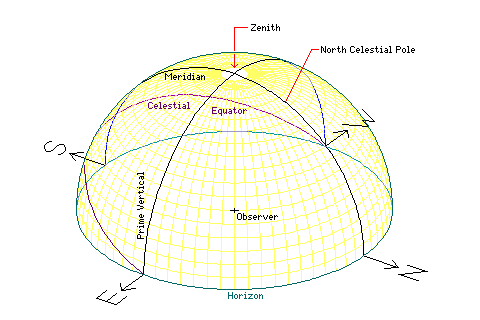
In astrology, the positions of the Sun and Moon in the sky are taken into account as influencing both events and the personalities of individuals. Their position in the twelve signs is among the things noted. But in a horoscope, featured even more prominently is the position of each planet among the twelve houses of the horoscope.
The signs of the zodiac occupy what is essentially a fixed position among the stars of the sky (moving very slowly with the precession of the equinoxes). The houses of the horoscope, on the other hand, reflect the exact time of birth, and usually depend on the geographical location where the person whose horoscope is being charted (typically referred to as the "native", meaning the person who was born at the time and place for which the horoscope is being cast) was born as well.
More than one scheme for dividing the sky into the twelve astrological houses has been proposed. To describe these schemes, it will be necessary to define some terms used in talking about the celestial sphere.

The point at the center of the diagram above is labelled "Observer" rather than "Native", as these definitions are as applicable to someone using a telescope to look at the night sky as they are to someone for whom a horoscope is being cast.
The circle on the celestial sphere that represents all the possible horizontal directions from the observer is called the horizon, a term familiar from ordinary language.
The point on the horizon directly north of the observer is called the North Point, and similar definitions apply to the other three cardinal points of the compass (South, East, and West).
The point on the celestial sphere that is directly overhead of the observer is called the Zenith.
The great circle which goes from the North Point through the Zenith to the South Point is called the Meridian. Telescopes mounted so that they can only swivel in one direction, so that they can only be aimed at points on the meridian, are called meridian circles, and by observing when a given star crosses the meridian each night at regular intervals of about 23 hours, 56 minutes, and 4 seconds, they were used to determine the Earth's rotation and make use of it as a standard of time.
The great circle which goes from the East Point through the Zenith to the West Point is called the Prime Vertical. Although it is not much used in astronomy, we will find that it plays an important role in the first house system we will examine, the Campanus house system.
The Meridian, the Prime Vertical, and the horizon all depend on the position of the observer. Another great circle shown on the diagram is instead part of the sky, located in the same place among the stars for observers anywhere on the Earth. This circle, the Celestial Equator, corresponds to the Earth's equator, projected from the center of the Earth on to the sky.
The North Celestial Pole is also shown on the diagram, near which the star Polaris is located. From the vantage point of the observer, it is 90 degrees away from every point on the Celestial Equator. It is located on the Meridian, 90 degrees along the Meridian away from the point where the Meridian crosses the Celestial Equator.
As the Earth rotates, all the stars seem to move along parallels of latitude in a graticule with the North Celestial Pole as its north pole and the Celestial Equator as its equator. Thus, long exposure photographs made with cameras pointed at Polaris show the stars leaving circular trails around it. (Note, incidentally, that the Meridian is a meridian of longitude in this system of coordinates as well as that with the North and South Points as its poles and the Prime Vertical as its equator, since they differ by being tilted along the Meridian.)
Typical maps of the night sky also use a system of coordinates in which the North Celestial Pole is the north pole, and the Celestial Equator is the equator, but one which is fixed among the stars. In this system, latitude is called declination, and longitude is called Right Ascension, and is measured in hours and minutes instead of in degrees.
To keep the diagram above from being too cluttered, one other circle, also part of the sky like the Celestial Equator, was left out. This circle plays a very important role in astrological house division.
To explain what that circle is, the diagram below, which resembles ones you have no doubt often seen in atlases, is provided:
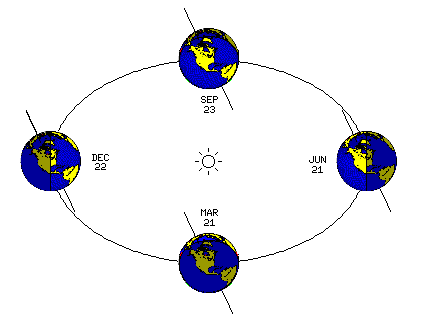
The Earth orbits the Sun in a plane called the Ecliptic. The Celestial Equator does not coincide with the Ecliptic; the Earth's axis, instead, is tilted, inclined, or offset by 23 1/2 degrees from the direction perpendicular to the Ecliptic.
This discrepancy is what gives rise to our seasons; in the winter, the Sun is further from being directly overhead, and so a given flux of radiation from the Sun is spread over a larger area of the Earth's surface, and days are shorter in the winter as well.
The great circle on the Celestial Sphere which represents directions along (or parallel with) the Ecliptic from the observer is also called the Ecliptic: as the Celestial Sphere is identified with space itself, this normally occasions no confusion.
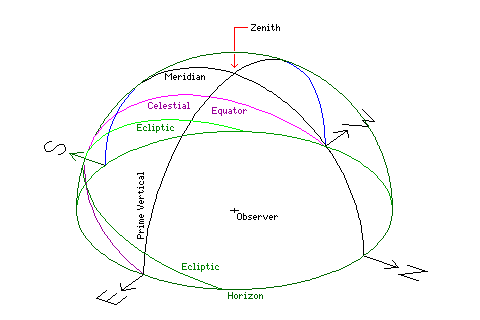
Thus, let us add the Ecliptic to our diagram. The Ecliptic is the center of the belt of constellations known as the Zodiac in which the other planets of the Solar System are seen in the night sky, as all the planets of the Solar System, including the Earth, very nearly orbit in the same plane. The planes of their individual orbits do, however, have small inclinations to one another, and so the Zodiac is a belt with some width.
An astronomical ephemeris will note the positions of the planets in the night sky by Right Ascension and Declination. Another coordinate system, using the Ecliptic as its equator, has Celestial Longitude for its longitude, and Celestial Latitude as its latitude. Unlike Right Ascension, Celestial Longitude is given in degrees.
An astrologer's ephemeris will usually give Celestial Longitude in the form of sign and degree (each of the 12 signs of the Zodiac being 30 degrees wide), and it will usually also give Declination (as opposed to Celestial Latitude, which belongs to the same coordinate system as Celestial Longitude) as that is used to determine if planets are in parallel aspect.
The Ecliptic is the (apparent) path of the Sun across the sky. The apparent motion of the Sun among the stars is to the left when North is upwards. This is because:
The Earth orbits the Sun in a counter-clockwise direction as seen looking down on the Solar System from above the North Pole.
Hence, from the Earth, the Sun appears to move around the Earth (as gauged against the background of stars) in a counter-clockwise direction as well.
The Sun rises in the East, however, as the Earth spins on its axis, also in a counter-clockwise direction, much more quickly (slightly more often than once a day) than it orbits the Sun (once a year).
It is because the Sun's apparent direction changes a little each day that the Earth spins on its axis once every 23 hours, 56 minutes, and 4 seconds, but because it has to catch up with the Sun's apparent movement each day, a day takes 24 hours.
The location of the signs of the (tropical) Zodiac along the Ecliptic is determined by its relation to the Celestial Equator.
The signs, in order from Aries to Pisces, each occupy 30 degrees along the Ecliptic; they are disposed in counter-clockwise order, from right to left along the sky.
The signs from Aries to Virgo are located to the north of the Celestial Equator, and the signs from Libra to Pisces are located to the south of the Celestial Equator.
Thus, 0 degrees of Aries, or the First Point of Aries, the point at which the Sun is seen in the sky at the time of the Vernal Equinox, is where the Ecliptic crosses the Celestial Equator, the Ecliptic being south of the Celestial Equator on the right, and being north of the Celestial Equator on the left.
While there are other house systems simpler than the Campanus house system, it is the simplest one from which the concepts on which astrological house systems are based can be explained.
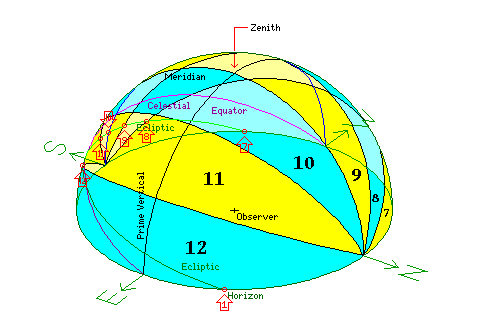
The sky is divided into twelve houses by dividing the Prime Vertical into twelve equal parts. The North and South points on the horizon are to the Prime Vertical as the poles are to the equator, and so great circles drawn from the North Point to the South Point through the Prime Vertical are like meridians of longitude.
The eastern and western horizons, and the Meridian, are among the twelve meridians in this system used to mark the division between houses.
And so the diagram shows that the seventh through ninth houses are located in the quadrant from the western horizon to the meridian, and the tenth through twelfth houses are located in the quadrant from the meridian to the eastern horizon.
To keep things simple for astrologers, however, tables of houses, instead of recording the entire path of the line between houses, give the boundary of each house as a single angular position. That is the location where the line bounding a house crosses the Ecliptic, since the planets always move close to the Ecliptic.
These points in the diagram are marked in red, with arrows pointing to them from below or above.
The first house cusp in the Campanus system is also called the Ascendant, and this point is important in almost all other house systems as well.
The tenth house cusp in the Campanus system is called the Midheaven or the Medium Coeli, and it is also important in many other house systems.
The Equal House system is perhaps the simplest house system; it uses the Ascendant as derived from the intersection of the Ecliptic and the eastern horizon, and then allocates 30 degrees along the Ecliptic to every house.
A Solar Chart is a special type of Equal House chart, in which the first house cusp is placed at the Sun's position instead of at the ascendant. This type of chart is particularly useful where the time of birth is unknown, and it is also applicable, as an example, to a birth on the Arctic Circle or the Antarctic Circle at a time when the Ecliptic coincides with the horizon, and thus no Ascendant is defined.
Actually, it is possible to have a house system even simpler than the Equal House system. In the Whole Sign system, the first house is the entire sign in which the Ascendant is located, regardless of on which degree in that house it is located.
The Porphyry house system was used in antiquity, and is only slightly less simple than the Equal House system. It divides the Ecliptic into three equal parts from the Ascendant to the Midheaven, and then into another three equal parts from the Midheaven to the Descendant (the point directly opposite the Ascendant), another three equal parts from the Descendant to the Immum Coeli (the point directly opposite the Midheaven, also known as the Medium Coeli), and then another three parts from the Immum Coeli to the Ascendant.
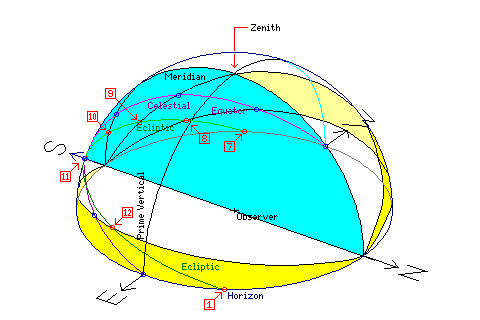
In the Regiomontanus system of house division, the boundaries between houses are also meridians of longitude in the system of coordinates in which the North Point and the South Point on the horizon are the poles. However, instead of being equally spaced, they are determined by dividing the Celestial Equator into twelve equal parts. As this division starts from the eastern horizon, which includes the Ascendant, the eastern and western horizons, and the Meridian, are house boundaries in this system as well as in the Campanus system.
This method, originally due to Haly Abenragel, is also known as the Ascendant-Parallel-Circle (APC) method, and is used by the Werkgemeenschap van Astrologen (WvA), also known as the Ram School, in the Netherlands. It is very similar to the Regiomontanus house system, but with one very important difference.

Instead of the Celestial Equator being divided into twelve equal parts, the parallel of declination (remember: the Celestial Equator is the parallel of zero degrees declination) on which the Ascendant (the point where the Ecliptic crosses the eastern horizon) is located is divided into six equal parts from the ascendant to where it crosses the western horizon (one of the divisions lying on the Meridian) and six equal parts from where it crosses the western horizon to the ascendant.
Again, great circles from the North Point to the South Point pass through the boundaries of these twelve parts of that parallel of declination, and the house cusps are where they intersect the Ecliptic.
This method also uses the parallel of declination on which the Ascendant is located, dividing it equally from the Ascendant. But it uses lines of constant Right Ascension, great circles from the North Celestial Pole, to project the house cusps to the Ecliptic.
In this system, the Celestial Equator is divided into twelve equal parts, with the points where it intersects the horizon and the Meridian among the divisions between the parts, and then it is projected to the ecliptic by great circles emanating from the North Celestial Pole.
In this system, the ascendant is not usually the first house cusp, and the house divisions depend only on the local sidereal time at birth.
In this system, the horizon is divided into twelve equal parts, the cardinal points being among the divisions, and the East Point indicating the first house cusp. The points of division are then projected on to the ecliptic from the North and South celestial poles.
The Midheaven is the tenth house cusp in this system, but the ascendant is not usually the first house cusp, and the house divisions only depend on the local sidereal time at birth.
A more distinctive characteristic of this system of house division, and the one which generally provides the primary motivation to make use of it, is that it works well at extreme northern and southern latitudes, although it will fail at the North and South poles, where the Meridian is not defined. As the North and South Celestial Poles approach the horizon at tropical latitudes, it will produce distorted houses there instead.
The boundaries between houses in the Placidus system are, in general, complex curves rather than great circles, with the exception of the horizon, the Meridian, and the Anti-Meridian (the other half of the great circle on the Celestial Sphere which includes the Meridian).
These boundaries can be drawn by dividing every parallel of declination into three equal parts from the eastern horizon to the meridian, from the meridian to the western horizon, and so on. Since the Ecliptic is inclined to the Celestial Equator, the precise declination of a point on the Ecliptic is not known if that point is not yet identified; thus, determining Placidean house cusps is a recursive process.
In the Koch system, divide the circle parallel to the Celestial Equator that intersects the ascendant (the point at which the Ecliptic intersects the eastern horizon) into three parts from the ascendant to the meridian, and from the meridian to the western horizon, and so on, as done in the Abenragel system.
Then, the intermediate cusps of the houses are found by taking the points created by this trisection, and projecting them to the ecliptic by means of circles parallel to the horizon. The MC and IC still serve as the 10th house and 4th house cusps respectively.
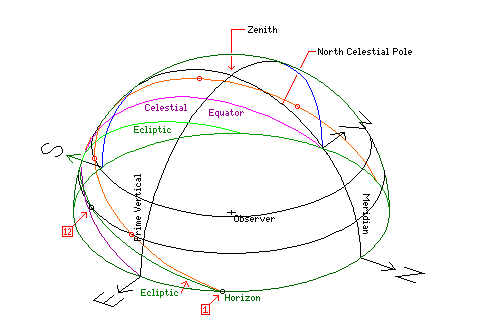
In the diagram above, only locating the twelfth house cusp is shown. Although the diagram still illustrates the principles on which the Koch system of house division is based, as it happens, it is drawn for a birthplace far enough north that the system breaks down, and the line dividing the eleventh house from the tenth house does not intersect the ecliptic.
The foregoing explanation agrees with what I have seen on some web sites. Others explain the system as dividing the sky based on what the horizon would have been when the ascendant has moved 1/3 or 2/3 of the way to the meridian, similarly to the Topocentric system, but without that system's adjustment to bring the horizon to the meridian as the ascendant approaches it.
This system uses parallels of declination to divide the prime vertical into parts, based on dividing the difference in declination between the east and west points and the Zenith into thirds. Then (apparently) great circles from the north point to the south point divide the sky and the eclipic.
Although the geometrical description of the Topocentric system was hard to follow for me, the description of how the house cusps are calculated was plain enough.
The ascendant and descendant serve normally as the cusps of the 1st and 7th houses.
The cusps of the 12th, 2nd, 6th, and 8th houses are calculated as though the birth took place at a longitude respectively 30 degrees east, 30 degrees west, 150 degrees west, and 210 degrees west of the actual place of birth (thus changing the sidereal time of birth but not the actual time of birth), and as though the birth took place at a latitude the tangent of which was 2/3 the tangent of the latitude of actual place of birth.
Similarly, the cusps of the 11th, 3rd, 5th, and 9th houses are calculated as the ascendants of horoscopes set at longitudes displaced by 60 degrees east, 60 degrees west, 120 degrees west, and 120 degrees east, and at a latitude the tangent of which is 1/3 the tangent of the latitude of the actual place of birth.
The MC and IC serve normally as the 10th and 4th house cusps.
Of course, this description, showing the house cusps as deriving from displacing the location of birth, is somewhat opposed to the spirit of the system, which intends to tie the chart more closely to the actual place of birth (hence the name, "Topocentric").
This discrepancy is more apparent than real. Instead of thinking of the native being born at a different longitude, it is equally permissible to think of using a tilted horizon.
Since the tilt of the horizon derives from a rotation about the North Celestial Pole, and not the North Point on the horizon, the change in latitude is done to cause the horizon to coincide with the meridian when a full 90 degrees of rotation is performed.
The house cusps, then, can be thought of as intersections between a circle of finite size corresponding to the ecliptic and a succession of planes. The horizon plane and the meridian plane are included in that set. The planes to produce the intermediate house cusps are generated by rotating the horizon plane around an axis parallel to the Earth's axis, and moving that plane towards the axis by decreasing its rise away from the axis over the run along the axis linearly, in proportion to the amount of rotation.
In this system, the great circle from the Ascendant (the point where the ecliptic crosses the eastern horizon) to the Zenith is divided into twelve equal parts, the Ascendant and Zenith being among the divisions between those parts, and then project that circle to the ecliptic by great circles emanating from the North Celestial Pole.
Copyright (c) 2012 John J. G. Savard